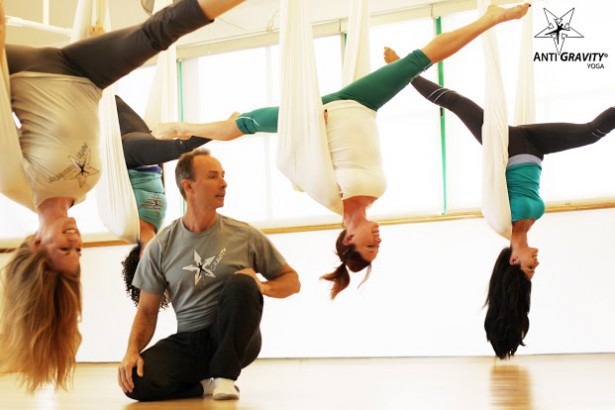Tried & Tested: Upside Motion AntiGravity® Aerial Yoga
mis à jour le 6 October 2015 à 23:38
After our insightful Q&A session with AntiGravity® expert Thicha, we decided to try AntiGravity® Aerial Yoga out for ourselves and see what it was all about.
I was initially rather daunted by the thought of dangling precariously from thin cloth, upside-down no less, for a full 55-minutes. Despite being a regular practitioner of other more ‘ordinary’ forms of yoga, such as vinyasa and ashtanga to name a few, I was nervous about trying this novel form of yoga, mostly because I didn’t know what to expect.
The Process:
Ming Lim was a great instructor – he eased us ladies into the practice expertly. He started off with getting us thoroughly familiarized with the AntiGravity® Hammocks and reassured us that they adjusted themselves to the weight of our bodies and ‘can take the weight of a baby elephant’ – so that’s about two hundred kilograms. He taught us how to hold it and stretch ourselves out, as well as how to warm up our muscles in preparation for hanging upside-down. After some basic stretching with the hammock, learning about positioning and how high up to hold it, we eventually were taught how to get into the hammocks and into simple poses.It’s entirely important to first become adept with maneuvering the hammock because proper hammock placement is the key to achieving effective aerial conditioning.
Most other aerial yoga methods teach students to achieve the optimum effects from strategic points of the body. AntiGravity® Aerial Yoga combines the two. In AntiGravity® aerial yoga, the hammock is placed on the body’s fulcrum point – the front (hip bones/hip flexors) and the back (scrum, tailbone) belt line and when that is achieved, we are able to effectively work the body out with the aerial silk hammock.
Within about twenty minutes, we were already practicing our first inversion. The zero compression inversion, Ming related, has the unique benefit of exerting absolutely no pressure on the spine and in fact, helps to strengthen it. The pose ensures that there is no compression on the spine but is instead elongated – relieving the body of any back pain or spasms. Ultimately, the zero gravity pose is the most ideal posture a person would want to maintain when standing straight up on the ground.
Our Verdict:
I was surprisingly, totally at ease being upside down. I didn’t worry about falling because, as Ming constantly reminded us, even if we let go, the hammock would support us. I felt almost weightless as I held each inversion for up to or more than a minute. I was amazed at how the nauseous feeling I had prior to the class, possibly owing to anxiety, was completely alleviated.
I’ll definitely be going back for some more inverted fun. The world seems to look so much better the wrong side up.
Read more about AntiGravity® from our Q&A with 1 -Star instructor and trainer Cholthicha Srivisal (Thicha).
Ming will be conducting an AntiGravity® Teacher Training course with Upside Motion on 8 to 11 of December 2014. AntiGravity Fitness is currently available in two places - Upside Motion and Virgin Active Singapore.
Diya-Maya Tsering Bhalla



